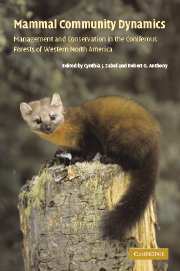 Mammal Community Dynamics
Mammal Community Dynamics Book contents
- Frontmatter
- Contents
- List of contributors
- Foreword
- Acknowledgments
- Part I Management and conservation issues for various taxa
- Part II Community and ecosystem relations
- 10 Relationships among fungi and small mammals in forested ecosystems
- 11 Ecology of coarse woody debris and its role as habitat for mammals
- 12 The ecological role of tree-dwelling mammals in western coniferous forests
- 13 The role of ungulates and large predators on plant communities and ecosystem processes in western national parks
- 14 The role of the lynx–hare cycle in boreal forest community dynamics
- 15 Associations of mammals with riparian ecosystems in Pacific Northwest forests
- Part III Conservation issues and strategies
- Index
- References
12 - The ecological role of tree-dwelling mammals in western coniferous forests
Published online by Cambridge University Press: 15 December 2009
- Frontmatter
- Contents
- List of contributors
- Foreword
- Acknowledgments
- Part I Management and conservation issues for various taxa
- Part II Community and ecosystem relations
- 10 Relationships among fungi and small mammals in forested ecosystems
- 11 Ecology of coarse woody debris and its role as habitat for mammals
- 12 The ecological role of tree-dwelling mammals in western coniferous forests
- 13 The role of ungulates and large predators on plant communities and ecosystem processes in western national parks
- 14 The role of the lynx–hare cycle in boreal forest community dynamics
- 15 Associations of mammals with riparian ecosystems in Pacific Northwest forests
- Part III Conservation issues and strategies
- Index
- References
Summary
Three groups of mammals that occur in coniferous forests of western North America are closely associated with large healthy, decaying, or dead trees: bats, arboreal rodents, and forest carnivores. Detailed descriptions of the ecological relations of these species are presented elsewhere in this book (Buskirk and Zielinski 2003, Hayes 2003, Smith et al. 2003). Although many other kinds of mammals use large vertical forest structures to some degree, these are the species groups that depend on them to meet their life history requirements. Consequently, these are also the mammals that are most likely to suffer population declines in forests where these structures are reduced in abundance. The need to provide for large snags and decadent trees in managed forests to maintain populations of cavity-using birds and mammals has received much attention in the literature (e.g., Balda 1975, Thomas 1979, Hoover and Wills 1984, Brown 1985). However, the perceived consequences of providing inadequate numbers and sizes of these structures in managed forests have generally been limited to the decline or loss of the wildlife species that depend on them. The broader ecological consequences that could also result from the loss or decline of tree-dwelling birds and mammals have received relatively little attention (but see Machmer and Steeger 1995, Aubry and Raley 2002).
Managing forests primarily for timber production often involves not only the removal of a substantial proportion of large, healthy trees from each harvest unit, but also the elimination of large dead or decadent trees.
- Type
- Chapter
- Information
- Mammal Community DynamicsManagement and Conservation in the Coniferous Forests of Western North America, pp. 405 - 443Publisher: Cambridge University PressPrint publication year: 2003
References
- 10
- Cited by


